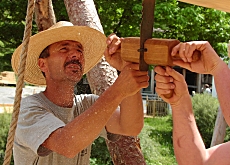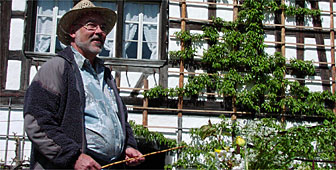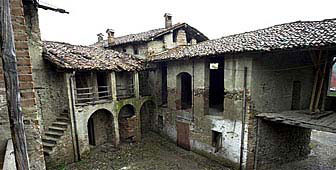Heritage site sharpens old axe for “new” house

The Ballenberg open-air museum in the Bernese Oberland is usually a final resting place for old farmhouses, not a building site for new ones.
But the museum’s management has made an exception this summer to shed light on how traditional Swiss farmhouses were built in the pre-industrial age.
The house chosen for the unique project, “Building as our ancestors did”, is a common labourer’s abode from the beginning of the 19th century.
The timber needed for the house was felled in the nearby woods last winter and transported by horse to Ballenberg where some logs were cut at the museum’s water-powered sawmill.
For the most part though, the craftsmen and their helpers are making the beams and planks by hand using an array of axes, adzes and chisels.
“When I’m trying to figure out how they accomplished some of the finer work, I wonder how they managed without the aids we have today,” says Hermes Thöni, the building site foreman.
Inside the work shed, a retired civil engineer, who has signed up for a carpentry course offered by Ballenberg in conjunction with the project, is being shown how to trim a beam with an adze.
He only manages a few imprecise hacks before downing the heavy, sharp-edged instrument to rest his tired arms.
His teacher is a carpenter less than half his age, who himself has had to learn the tools of the ancient trade. Each beam requires around 30 man-hours to finish.
Dying out
“The biggest problem was finding skilled labourers who have kept the crafts alive,” explains Edwin Huwyler, responsible for the historical research to ensure the project’s authenticity.
“Some of these people are still around, but they are in their 70s or 80s. They told us they could demonstrate how beams were once cut, but they didn’t have the strength any more to do all the work themselves.”
Course participant Urs Jäggin – a monument conservator for the city of Zurich – believes that he has been gaining valuable insights by taking part in the project.
“We are watching the entire construction process unfold. That is something we don’t see when we evaluate old buildings,” he adds. “It should enable us to make better assessments in future.”
The aim is to complete the house by October. Visitors are invited to watch the work in progress; either by travelling to the museum near Brienz, or by viewing it on the site’s webcam (see related site).
Stonemasons, glass blowers, glaziers, cabinetmakers and blacksmiths back up the carpenters, while the course participants represent the dozens of villagers who in earlier times had to lend a hand.
The way labour was organised paints a picture of what house building meant to society in rural Switzerland 200 years ago. Huwyler says most people lived under their own roof, but homes were only built when absolutely necessary due to the value of timber and the commitment required from the community.
“Each family was obliged to give the builder a tree, which they transported to the site themselves and they also had to offer their services when necessary,” he explains.
Ritual feasts
The few hired hands received a couple of francs a day, food and lodging. They also expected the builder’s family to organise ritual feasts marking the completion of each important stage of construction, to which the villagers were invited.
The key events were the laying of the foundation stone, erecting the top roof beam (to be celebrated in Ballenberg on Swiss National Day – August 1), and the day when all the final fittings and locks were put in place.
A surviving family document from the construction of a house in the Bernese village of Münchenbuchsee, dated April 6, 1766, reveals that the builder’s brothers donated two barrels of wine, 15 hams and 25 baskets of cake to satisfy the hunger and thirst of the 70 workers after they had put the top beam in place.
The crowning moment of the celebration came when a small fir tree was nailed to the highest point of the roof to protect the house from disaster and demons. But the carpenters had the right to replace it with a broom or upside down cup if they felt the builder’s family was being stingy with the wine.
The 19th century Swiss author, Jeremias Gotthelf, described another unpleasant side-effect of relying on neighbours: “As long as it stands, those who brought wood will always say when they pass by, ‘I also gave a fir tree for that house’.”
This will never happen at Ballenberg. Since the museum is the preserve of authentic old buildings, the house will be immediately dismantled upon completion. The last nail will also be the final nail in its coffin.
swissinfo, Dale Bechtel in Brienz
Ballenberg is Switzerland’s open-air museum for rural culture, with about 100 old farmhouses from across the country reconstructed on the site.
It is also home to rare species of farm animals, and keeps alive ancient crafts.
Foods and other products made at Ballenberg can be purchased on site.
Around a hectare of forest was needed to provide the timber for a simple village house in the 18th or early 19th century. This did not include the large amount of firewood or wood for fence making required by each household.
The depletion of the forests was a serious environmental problem and of great economic concern for rural Switzerland up until the 20th century.
Neighbours not only gave timber to build a new house, but also donated windows and doors complete with metal hinges and handles.

In compliance with the JTI standards
More: SWI swissinfo.ch certified by the Journalism Trust Initiative




You can find an overview of ongoing debates with our journalists here. Please join us!
If you want to start a conversation about a topic raised in this article or want to report factual errors, email us at english@swissinfo.ch.